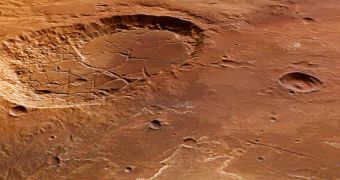Officials with the European Space Agency (ESA) say that their Mars Express orbiter has recently been able to collect a series of images depicting a very large crater on the surface of the Red Planet. Informally known as the Ladon Basin, the landscape feature is 440 kilometers (273.4 miles) across.
The double interconnected impact craters Sigli and Shambe are the primary points of attraction in this image, as are their cracked floors. At this point, planetary scientists are not exactly sure as to what exactly caused this extensive fracturing.
ESA scientists used the High-Resolution Stereo Camera (HRSC) instrument on Mars Express to capture these photographs on April 27. The team says that the photos provide additional evidence that liquid water and rivers once existed on the surface of the Red Planet.
“The interconnected craters Sigli and Shambe are thought to have formed later when an incoming projectile split into two pieces just before impact. The joined craters were then partly filled with sediments at some later epoch,” the team explains.

 14 DAY TRIAL //
14 DAY TRIAL //